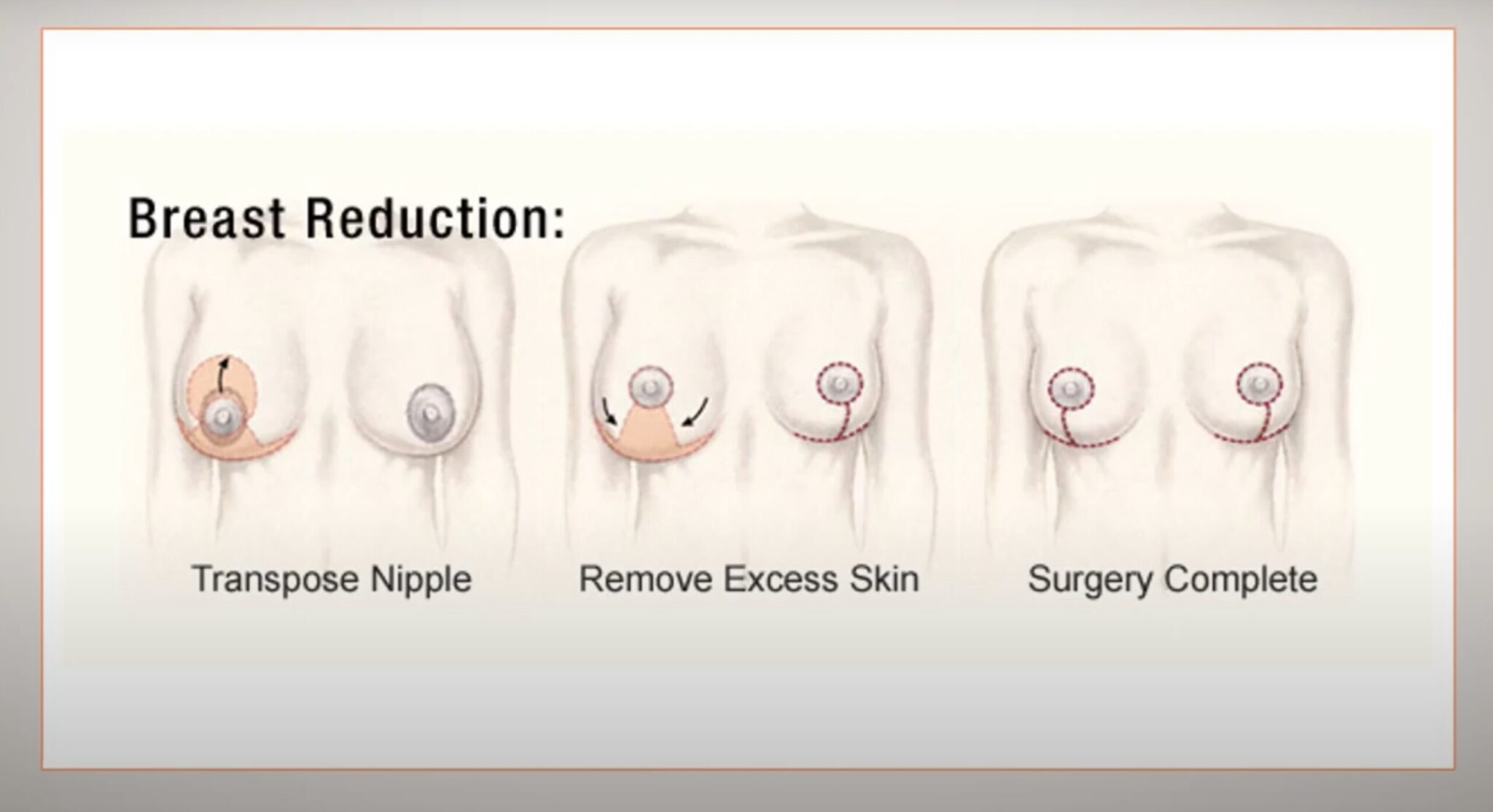Large Breast Symptoms
Having large breasts can lead to several symptoms. These include:
- Back pain (at the level of the shoulder blades)
- Bra strap grooving (irritating the trapezius muscle or shoulders)
- Skin irritation (where the skin of the breast sits against the chest wall, leading to infections and yeast build up)
- Difficulty fitting clothing
- Difficulty with exercise
Bra Size
Bra size is based on the chest size and the point of maximal projection of the breast tissue. For example, if someone has a chest size that is a 36, that means there is 36 inches around their chest.
If their bra size is a 36B cup, that means the point of maximal projection of the breast tissue is four inches further than the chest itself. So the breast would stick out an additional four inches. However, when measuring the breast size, there is no accounting for this projection being when the breasts are left to hang, whether they’re being held up by someone’s hand, or whether they’re inside a bra. All of which would change the maximal breast projection.
In addition, one can see how the chest size will dramatically influence the amount of tissue in the breast. If someone has a smaller chest size, such as this woman, they may have a chest size of 28. If their cup size is a D, the breasts project another eight inches. And although they have a D cup, their breasts may be smaller than the woman who is a 36B.
Another thing that makes it difficult to talk about breast cup size and changes with surgery is how the breasts are reduced in size. If this woman were to undergo a breast reduction surgery, a lot of the volume removed from the breast may be along the lower pole.
As a result, her postoperative profile may be very similar in the projection of the breast tissue away from the chest wall. However, the amount of low hanging breast tissue is much less after surgery. If bra measurements are used, her chest size would be the same, pre and post operatively. And in this case her breast projection may be very similar pre and post operatively, but clearly there is less weight and less breast tissue. Hence, she will have improvement in her symptoms of back pain, shoulder strap grooving, and difficulty with activities.

Asymmetry Between The Breasts
All patients will have some degree of asymmetry between the breasts. Sometimes it is minor and sometimes it can be very significant. Asymmetry in terms of volume can be adjusted for with surgery. However, other parts of the asymmetry cannot be. If someone has two breasts that are asymmetrical, certain factors cannot be made more symmetrical.
The larger breast will sit lower on the chest wall. This lower take off or foot plate cannot be adjusted for with surgery. The larger breast will also have a wider take off on the chest, or wider foot plate. This cannot be corrected with surgery.
Finally, the larger breast will tend to hang in a more outward or lateral position with the nipple pointing more towards the side and sitting slightly lower. The nipple position can be improved, however, the general lie of the breast is often somewhat asymmetric even if the volume is made more symmetrical with breast reduction surgery.
Breast Reduction Surgery Symptoms Not Treated
The back pain associated with having large, pendulous breasts is typically located between the shoulder blade. Back pain that is at the level of the neck or in the lower area of the back, as shown here, is often not relieved with a breast reduction surgery. In addition, pain within the breasts themselves generally is not well treated with breast reduction surgery.
Who is Not a Candidate for Breast Reduction Surgery
Not everyone is a great candidate for breast reduction surgery.
- Patients who are unable to have a general anesthetic.
- Patients who have a basal metabolic index above 30.
- Patients who are cigarette smokers cannot safely have a breast reduction.
After smoking cessation for at least three months, someone may be a candidate for breast reduction surgery.
If you do choose to undergo breast reduction surgery, marks are placed on the breast tissue prior to the beginning of the operation. These marks are used to design a pattern that will allow removal of both breast tissue and skin.The type of breast reduction that is performed depends on the surgeon’s experience, the patient’s desire, and the type of breasts the patient has when they come to the office.

This diagram shows an example of an inverted T breast reduction. During the reduction, the nipple is not removed, but it is transposed or shifted into a higher position if it has fallen with gravity. Excess tissue, which includes breast tissue, fat, and skin, is removed as drawn in the second picture.
Finally, as drawn in the third picture the incisions are sewn closed. This typically will leave the patient with an incision around the nipple areola complex. An incision that goes vertically down the breast and to a variable degree, a horizontal incision underneath the breast itself.
Drains for Breast Reduction Surgery
After surgery, patients usually go home the same day. Drains are left in place. The purpose of the drain is to collect fluid that builds up in the breast tissue. The fluid that builds up can lead to slower healing and inflammation. Not all surgeons use drains. In my experience, having used drains and done surgery without drains, I feel that results are better if the patients have drains in place. The drains will usually come out within two to three days.
Breast Reduction Surgery Side Effects
If you are to have breast reduction surgery, there are certain things that you can expect.
- Change in the breast size
- Scars
- Change in nipple sensation
- Pain
- Reduced ability to breast feed
There will be a change in the breast size, a reduction of course. There will be scars, as described earlier, along the incision lines. There will be changes in nipple sensation. In most patients, the nipple sensation and erectile function of the nipple returns after surgery. However, this is not the case for all patients.
If erectile function of the nipple and nipple sensation is very important to you, you should think very carefully before proceeding with breast reduction surgery. To a variable degree, after surgery there is pain.
Patients typically take painkillers for the first day, up until the first week. After that pain may be ongoing, however, most people stop taking any pain medication after about seven days. There will also be a reduced ability to produce breast milk. If breastfeeding is very important to you, it is better to wait until after childbirth and breastfeeding for breast reduction surgery.
Breast Reduction Surgery Possible Complications
As with any other surgery, there can be risks and complications.
- Asymmetry
- Loss of nipple sensation
- Loss of erectile function
- Change of areola color
- Seroma
- Bleeding
- Infection
- Problems with anesthesia
- Poor wound healing (fat necrosis)
- DVT/PE
Patients will always have some degree of asymmetry in the breasts. Certain types of asymmetry can be improved, but not necessarily corrected 100%. As well, most patients will have some asymmetry after surgery; however, this should not be significant or severe.
Patients may lose total nipple sensation, as discussed before, or loss of erectile function of the nipple. The areola tissue, the dark tissue around the nipple, may change color. Patients may have a build up of fluid known as a seroma. Patients may have bleeding after surgery that requires going back to the operating room. If patients have significant bleeding, this usually occurs within 24 hours after surgery. For this reason, patients should stay near the hospital or within driving distance for the first 24 hours.
Infections after breast reduction surgery are possible; however, they are not common. Patients could have problems with anesthesia, these can be minor or significant. Patients may have poor wound healing or fat necrosis, which we will elaborate on and patients may have blood clots develop in the lower extremity or in the lung that can be very serious after any type of surgery, including breast reduction surgery.
Fat Necrosis
Fat necrosis is the most common concern after breast reduction surgery. This involves breast tissue that does not have enough blood supply to heal well after the surgery. Generally, breast tissue itself has a very poor blood supply. With larger breasts, this effect is increased.
If a patient does develop fat necrosis, they will note warmth and heat in the breast tissue at about two to three weeks after surgery. They may even have a breakdown in the skin, as seen here in this picture. They will develop heat, redness, pain, and tenderness. Much like an infection. If not treated immediately, fat necrosis will develop into a serious infection.
When patients develop fat necrosis, they should come back to see the surgeon immediately. They will often be required to go on an extended period of low dose antibiotics. Sometimes for one to three weeks. Once this settles, patients will notice an area of tenderness where the fat necrosis took place. This is deep scar tissue and that firm area of tenderness may be present for one to two years.
Risk factors for fat necrosis include:
- Smoking cigarettes
- Basal metabolic index > 30
- Diabetes
- Advanced age
- Prior chest surgery
- Radiation
- Very large reductions
The literature quotes a fat necrosis rate overall of approximately 20%.
Expected Course After Breast Reduction Surgery
Breast reduction surgery is a day surgery. Patients come to the hospital, have surgery, and then require a ride home or a ride to a nearby hotel after surgery. Because you have a general anesthetic, you are required to have someone stay with you the night after the surgery. We recommend that if you are from one of the smaller Gulf Islands or out of town, that you stay within driving distance from the hospital for the first night after surgery.
After surgery, you can take a shower immediately and we also recommend that you start to ambulate or walk immediately. There is no swimming or submersion for six weeks after surgery to keep the incisions clean and to avoid an infection. Drains are generally removed at the office or hospital after two to three days.
Most patients are out and about, out of the house by the beginning of the second week. You may start non-physical employment at work after two to four weeks. You can resume full activity at six weeks. The final result and full recovery will take six months. Patients who have fat necrosis after surgery will have a delayed recovery.
In summary:
- Non-smokers with a BMI less than 30 are good candidates for breast reduction surgery.
- Surgery can improve back and neck pain, make it easier to exercise and improve the appearance of the breast mound.
- Patients with risk factors of fat necrosis may require extended post-operative antibiotics and may have a delayed recovery.
- The majority of patients who undergo breast reduction are happy with their decision.
Case 1 – Breast Reduction Surgery
This 31 year old woman underwent bilateral breast reduction surgery with removal of approximately 600 grams of tissue from each side, or a total of 1.2 kilograms. After surgery, she had improvement in her back pain, shoulder strap grooving, and found it easier to exercise and to fit into various types of clothing. This is the same patient after her breast reduction surgery. After surgery she noted an immediate improvement in her posture.
Case 2 – Breast Reduction Surgery
These photographs are of a 58 year old woman who underwent bilateral breast reduction with removal of approximately 500 grams of breast tissue. After surgery, she also had an improvement in her back pain, shoulder strap grooving, and skin irritation. This is the same patient after her breast reduction surgery. As she was an older patient, she did have an extended recovery on the right side with a small amount of fat necrosis. However, this did not affect her end result.
If you have other questions, please feel free to contact us on our website or make an appointment at the office. Patients who wish to have breast reduction surgery, covered through the medical services plan, will need a referral from their family doctors.

